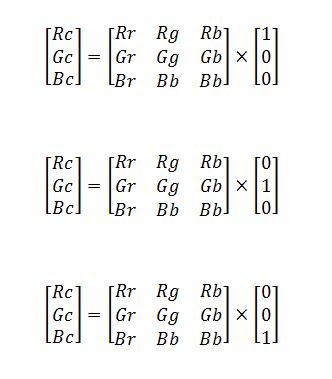If math is not your friend, stop reading right now. You don’t need to know what’s in this section, and it will likely confuse you. However, if you looked at the spreadsheet in the previous page and want to know where the formulae came from, this is for you.
Here goes:
If the monitor’s gamma is ɤ, and the signals fed to the monitor are:
The amount of light from each primary emitted by the monitor is:
If the camera is linear, there is a matrix that relates the monitor values to the values in the raw file as follows:
If the range of the monitor inputs in normalized to [0,1], the following are true:
Since one to the gamma is one.
Thus if we apply a full scale red signal as the stimulus and look as the captured values in the raw file, we can read the first column of the above square matrix:
Similarly with green:
And blue:
So now we have everything we need to predict the camera values from the monitor inputs:
Or, put another way,
But we really want the equation to give us the monitor values necessary to produce given, UniWB values in the camera. For that, we need to invert the matrix as follows:










Leave a Reply